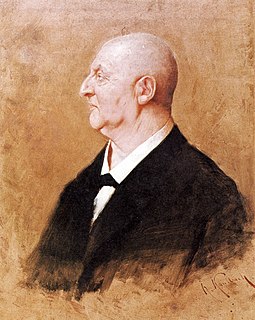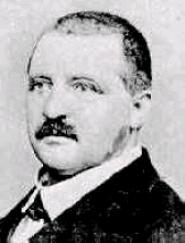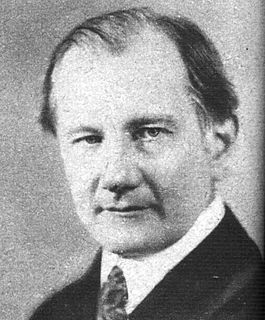Related Research Articles
Robert Wilfred Levick Simpson was an English composer, as well as a long-serving BBC producer and broadcaster.

Eugen Jochum was a German conductor, best known for his interpretations of the music of Anton Bruckner, Carl Orff, and Johannes Brahms, among others.

The Symphony No. 5 in B-flat major, WAB 105, by Anton Bruckner was written in 1875–1876, with minor changes over the next two years. It came at a time of trouble and disillusion for the composer: a lawsuit, from which he was exonerated, and a reduction in salary. Dedicated to Karl von Stremayr, education minister in the Austro-Hungarian Empire, the symphony has at times been nicknamed the "Tragic", the "Church of Faith" or the "Pizzicato"; Bruckner himself referred to it as the "Fantastic" without applying this or any other name formally.

Anton Bruckner's Symphony No. 7 in E major, WAB 107, is one of the composer's best-known symphonies. It was written between 1881 and 1883 and was revised in 1885. It is dedicated to Ludwig II of Bavaria. The premiere, given under Arthur Nikisch and the Gewandhaus Orchestra in the opera house at Leipzig on 30 December 1884, brought Bruckner the greatest success he had known in his life. The symphony is sometimes referred to as the "Lyric", though the appellation is not the composer's own, and is seldom used.

Anton Bruckner's Symphony No. 8 in C minor, WAB 108, is the last symphony the composer completed. It exists in two major versions of 1887 and 1890. It was premiered under conductor Hans Richter in 1892 at the Musikverein, Vienna. It is dedicated to the Emperor Franz Joseph I of Austria.

The Symphony No. 9 in D minor, WAB 109, is the last symphony on which Anton Bruckner worked, leaving the last movement incomplete at the time of his death in 1896; Bruckner dedicated it "to the beloved God". The symphony was premiered under Ferdinand Löwe in Vienna in 1903.

| performed = 9 May 1868: Linz | published = 1893 | first_recording = Volkmar Andreae, Austria State Symphony Orchestra, 1950 }} Anton Bruckner's Symphony No. 1 in C minor, WAB 101, was the first symphony the composer thought worthy of performing, and bequeathing to the Austrian National Library. Chronologically it comes after the Study Symphony in F minor and before the "nullified" Symphony in D minor. The composer gave it the nickname Das kecke Beserl, and conducted its 1868 premiere. Much later, after Bruckner was granted an honorary University of Vienna doctorate in 1891, he dedicated the 1890 version of the work to that institution.

Anton Bruckner's Symphony No. 2 in C minor, sometimes known as the "Symphony of Pauses", was completed in 1872. It was actually the fourth symphony composed by Bruckner, after the Symphony in F minor (1863), the Symphony No. 1 in C minor (1866), and the Symphony in D minor (1869).

Anton Bruckner's Symphony No. 3 in D minor, WAB 103, was dedicated to Richard Wagner and is sometimes known as his "Wagner Symphony". It was written in 1873, revised in 1877 and again in 1889.

Anton Bruckner's Symphony No. 4 in E-flat major, WAB 104, is one of the composer's most popular works. It was written in 1874 and revised several times through 1888. It was dedicated to Prince Konstantin of Hohenlohe-Schillingsfürst. It was premiered in 1881 by Hans Richter in Vienna to great acclaim.
Symphony No. 2 in E minor was written by Wilhelm Furtwängler between 1945 and 1946 in Switzerland. It is in four movements:
- Assai moderato - Allmählich belebend - Von hier ab festes Tempo (Allegro)
- Andante semplice (Tranquillo)
- Un poco moderato - Più Allegro - Più Moderato - Allegro - Moderato - Allegro
- Langsam - Moderato andante - Allegro molto - Moderato - Langsam - Moderato - Presto

The Te Deum in C major, WAB 45, is a setting of the Te Deum hymn, composed by Anton Bruckner for SATB choir and soloists, orchestra, and organ ad libitum.

The Mass No. 3 in F minor, WAB 28, is a setting of the mass ordinary for vocal soloists, chorus and orchestra, and organ ad libitum, that Anton Bruckner composed in 1867–1868.

The Requiem in D minor, WAB 39, is a Missa pro defunctis composed by Anton Bruckner in 1849.

Anton Bruckner's String Quintet in F major, WAB 112 was composed in 1878/79 in Vienna.

The Mass No. 1 in D minor, WAB 26 by Anton Bruckner, is a setting of the Mass ordinary for soloists, mixed choir and orchestra, and organ.

The Symphony No. 2 in E, Op. 40, was completed by Ernő Dohnányi in 1944, at the close of the Second World War. It was revised later in the 1950s. Written with audible roots in the Romantic tradition, the work is largely lyrical, yet maintains a controlled militaristic air inspired by the events surrounding its composition. It references a variety of musical backgrounds, including the work of Brahms, Wagner, Kabalevsky, and Bach. Bach's song Komm, süßer Tod serves as the basis for a significant portion of the finale.

The Symphony in D minor, WAB 100, was composed by Anton Bruckner in 1869 between Symphony No. 1 (1866) and Symphony No. 2 (1872). In 1895 Bruckner declared that this symphony "gilt nicht" and he did not assign a number to it. The work was published and premiered in 1924.
There have been many different versions and editions of the symphonies of Anton Bruckner.

Gerd Schaller is a German conductor, best known for his performing and recording rare works, including the first full recordings of Bruckner's output.
References
- ↑ David Griegel – Bruckner Symphony Versions (rev. 2009)
- ↑ Uwe Harten, Anton Bruckner - Ein Handbuch, Residenz Verlag , Salzburg, 1996 p. 410 - ISBN 3-7017-1030-9
- ↑ MWV - Anton Bruckner: Symphony in F minor
- ↑ Guennadi Rojdestvenski - Bruckner, Symphonies en fa mineur dite Symphonie "Double Zéro" - Le Chant du Monde, LDC 278. 852
- ↑ Hans-Hubert Schönzeler (1970): 67. "No. 1 he always called 'das kecke Beserl' (impossible to translate into English—perhaps 'the cheeky brat')."
- ↑ "Symphony in B-flat Major (sketch)". Abruckner.com. Retrieved 2012-08-27.
- ↑ Derek Watson, Bruckner. New York: Schuster & Macmillan (1997): 80. "That Symphony No. 2 is in C minor has actually been cited as a proof of Bruckner's naïvety as a composer."
- ↑ Robert Simpson, The Essence of Bruckner: An essay towards the understanding of his music. London: Victor Gollancz Ltd (1977): 64. "At this time Bruckner was more obsessed with Wagner's music than at any other time in his life, and the symphony contained a number of deliberate quotations from, mainly, Tristan und Isolde , Die Walküre and Die Meistersinger . This was the version Wagner saw and of which he accepted the dedication; Bruckner sent him a fair copy of the 1874 score."
- ↑ "Discography of Symphony No. 5". Abruckner.com. Retrieved 2012-08-27.
- ↑ Derek Watson, Bruckner. New York: Schuster & Macmillan (1997): 101. The Fifth was "the only one of his numbered and completed symphonies of which he was never to hear a note played."
- ↑ Robert Simpson (1977): 123. "The Sixth is the shortest of the fully mature symphonies. It has always been neglected, and I have never been able to understand why, for it has consistently struck me ... as among his most beautiful and original works; his own high opinion of it seems thoroughly justified."
- ↑ Derek Watson, Bruckner. New York: Schuster & Macmillan (1997): 113. The Eighth "which he regarded as his finest work, caused him the greatest emotional strain of his whole career."
- ↑ Deryck Cooke, New Grove (1980), 3:361.
- ↑ Robert Simpson (1977): 181–182. "When Bruckner knew that he might not finish the Ninth he suggested that the Te Deum could be used as a finale, and the presence in the sketches of a motive ... led to the supposition that he was composing some kind of link between the two works. There is no evidence to suggest that Bruckner, even in the poor state of health and mind the last few months of his life, considered the use of the C major Te Deum as finale to a D minor symphony to be more than a makeshift solution."
- ↑ Lionel Tacchini. "Arcor.de". Home.arcor.de. Retrieved 2012-08-27.
- ↑ https://www.amazon.co.uk/Bruckner-Symphonies-4-9-Otto-Klemperer/dp/B008YKRRH2; https://www.gramophone.co.uk/review/bruckner-symphony-no-4-28
- ↑ "Bruckner Symphony Cycle – Staatskapelle Berlin, Daniel Barenboim, music director and conductor – January 19–29, 2017", performance details, Carnegie Hall
- ↑ Gennadi Rozhdestvensky and the 1887 version of the Symphony No. 8